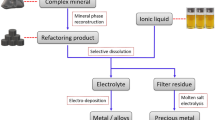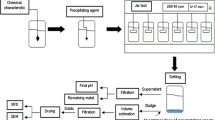Abstract
The removal of sulfur impurities from refining slag by external electric field is an important research direction of metallurgical solid waste recycling. In this study, Fourier transform infrared spectrometer, Raman spectroscopy, X-ray diffraction analyzer, rotating viscometer, and four-electrode conductivity tester were used to obtain the relationship between composition, structure, and properties of CaO–SiO2–Al2O3–MgO–CaF2 refining slag system. The effect of slag properties on the transfer efficiency of sulfur element enhanced by electric field was analyzed based on pulsed electric field experiment. The results showed that, when CaO/Al2O3 ratio changed from 1.2 to 2.0, the depolymerization of slag network structure and the disappearance of high-melting-point phases made the viscosity to decrease and the electrical conductivity to increase. When the MgO content changed from 4 to 12 wt%, under the influence of slag network depolymerization and the precipitation of high-melting-point phases, the viscosity decreased first and then increased, and the electrical conductivity trend was opposite. With the increase of F− content in the range of 3–7 wt%, the viscosity decreased first and then increased due to the depolymerization of slag network structure and the bonding of excess F− irons, and the electrical conductivity trend was opposite. According to the sulfur migration in refining slag, 0.5 h was determined as the suitable time parameter of applied electric field. When the voltage was 0–4 V, the electric field and the simplification of slag network structure can obviously promote the sulfur removal from slag. When the voltage was 6 V, the sulfur element in slag increased with the increase of CaO/Al2O3 ratio, and one reason was an increase in electrical resistance.
Graphical Abstract





















Similar content being viewed by others
References
Wang Z, Sohn II (2018) A review on reclamation and reutilization of ironmaking and steelmaking slags. J Sustain Metall 5(1):127–140. https://doi.org/10.1007/s40831-018-0201-5
Mercado-Borrayo BM, Gonzalez-Chavez JL, Ramirez-Zamora RM et al (2018) Valorization of metallurgical slag for the treatment of water pollution: an emerging technology for resource conservation and re-utilization. J Sustain Metall 4(1):50–67. https://doi.org/10.1007/s40831-018-0158-4
Yang J, Firsbach F, Sohn II (2022) Pyrometallurgical processing of ferrous slag “co-product” zero waste full utilization: a critical review. Resour Conserv Recycl 178:106021. https://doi.org/10.1016/j.resconrec.2021.106021
Liu C, Huang S, Wollants P et al (2017) Valorization of BOF steel slag by reduction and phase modification: metal recovery and slag valorization. Metall Mater Trans B 48(3):1602–1612. https://doi.org/10.1007/s11663-017-0966-0
Hiraki T, Kobayashi J, Urushibata S et al (2012) Removal of sulfur from CaF2 containing desulfurization slag exhausted from secondary steelmaking process by oxidation. Metall Mater Trans B 43(4):703–709. https://doi.org/10.1007/s11663-012-9685-8
Allertz C, Du S (2015) Possibility of sulfur removal from ladle slag by oxidation in the temperature range 1373–1673 K. J Sustain Metall 1:229–239. https://doi.org/10.1007/s40831-015-0018-4
Kim DH, Kim W, Kang YB (2018) Electrochemical desulfurization of molten steel with molten slag: reaction rate and current efficiency. J Electrochem Soc. https://doi.org/10.1149/2.0991814jes
Kim DH, Kim W, Kang YB (2018) Electrochemical transfer of S between molten steel and molten slag. Metall Mater Trans B 49(3):1311–1321. https://doi.org/10.1007/s11663-018-1213-z
Li JM, Li S, Jin L et al (1994) Modification of solidification structure by pulse electric discharging. Scripta Metal Mater 31(12):1691–1694. https://doi.org/10.1016/0956-716X(94)90465-0
Kim DH, Kang YB (2021) An attempt to correlate electrochemical desulfurization of molten iron using CaO-Al2O3-MgOsat. molten slag and applied electricity at 1673 K (1400℃). Metall Mater Trans B 52(5):2960–2970. https://doi.org/10.1007/s11663-021-02289-1
Judge WD, Paeng J, Azimi G (2022) Electrochemical study on molten iron-carbon electrodes in slag and their decarburization by slag/metal reaction. Electrochim Acta 406:139801. https://doi.org/10.1016/j.electacta.2021.139801
Wang HC, Liao ZY, Wang BW et al (2021) Research progress of impurity removal from metallurgical slag and strengthening metallurgical process by external electric field. J Energy Nat Resour 10(2):39. https://doi.org/10.11648/j.jenr.20211002.11
Farahat R, Eissa M, Megahed G et al (2019) Effect of EAF slag temperature and composition on its electrical conductivity. ISIJ Int 59:216–220. https://doi.org/10.2355/isijinternational.ISIJINT-2018-507
Jiao Q, Themelis NJ (1988) Correlations of electrical conductivity to slag composition and temperature. Metall Mater Trans B 19:133–140. https://doi.org/10.1007/BF02666499
Zhang P, Liu J, Wang Z et al (2019) Effect of B2O3 addition on electrical conductivity and structural roles of CaO-SiO2-B2O3 slag. Metall Mater Trans B 50(1):304–311. https://doi.org/10.1007/s11663-018-1472-8
Wu T, Wang Q, Yu CF et al (2016) Structural and viscosity properties of CaO-SiO2-Al2O3-FeO slags based on molecular dynamic simulation. J Non Cryst Solids 450:23–31. https://doi.org/10.1016/j.jnoncrysol.2016.07.024
Sohn II, Min DJ (2012) A review of the relationship between viscosity and the structure of calcium-silicate-based slags in Ironmaking. Steel Res Int 83:611–630. https://doi.org/10.1002/srin.20120004018
Lyu S, Ma X, Chen M et al (2020) Application of phase equilibrium studies of CaO-SiO2-Al2O3-MgO system for oxide inclusions in Si-deoxidized steels. Calphad. https://doi.org/10.1016/j.calphad.2019.101721
Xu JF, Zang JY, Jie C et al (2011) Experimental measurements and modelling of viscosity in CaO-Al2O3-MgO slag system. Ironmak Steelmak 38(5):329–337. https://doi.org/10.1179/1743281210Y.0000000014
Ju JT, Lu ZL, Jiao ZY et al (2012) The Relationship between viscosity and electrical conductivity of CaF2-SiO2-Al2O3-CaO-MgO Slag System. Mater Sci Forum 724:460–463. https://doi.org/10.4028/www.scientific.net/MSF.724.460
Toplis MJ, Dingwell DB (2004) Shear viscosities of CaO-Al2O3-SiO2 and MgO-Al2O3-SiO2 liquids: implications for the structural role of aluminium and the degree of polymerisation of synthetic and natural aluminosilicate melts. Geochim Cosmochim Acta 68(24):5169–5188. https://doi.org/10.1016/j.gca.2004.05.041
Park JH, Dong JM, Song HS (2002) The effect of CaF2 on the viscosities and structures of CaO-SiO2 (-MgO)-CaF2 slags. Metall Mater Trans B 33(5):723–729. https://doi.org/10.1007/s11663-002-0026-1
Park JH, Dong JM, Song HS (2004) Amphoteric behavior of alumina in viscous flow and structure of CaO-SiO2 (-MgO)-Al2O3 slags. Metall Mater Trans B 35(2):269–275. https://doi.org/10.1007/s11663-004-0028-2
Park JH, Dong JM (2004) Effect of fluorspar and alumina on the viscous flow of calcium silicate melts containing MgO. J Non Cryst Solids 337(2):150–156. https://doi.org/10.1016/j.jnoncrysol.2004.03.109
Wang WL, Cao XZ, Jiang T et al (2016) Relation between electrical conductivity and viscosity of CaO-SiO2-Al2O3-MgO System. ISIJ Int 56(2):205–209. https://doi.org/10.2355/isijinternational.ISIJINT-2015-502
Zhang GH, Xue QG, Chou KC et al (2011) Study on relation between viscosity and electrical conductivity of aluminosilicate melts. Ironmak Steelmak 38(2):149–154. https://doi.org/10.1179/030192310X12816231892585
Zhang GH, Chou KC (2012) Correlation between viscosity and electrical conductivity of aluminosilicate melts. Metal Mater Trans B 43(4):849–855. https://doi.org/10.1007/s11663-012-9674-y
Park JH, Min DJ, Song HS (2002) Structural investigation of CaO-Al2O3 and CaO-Al2O3-CaF2 slags via fourier transform infrared spectra. ISIJ Int 42(1):38–43. https://doi.org/10.2355/isijinternational.42.38
Kim GH, Kim CS, Sohn II (2013) Viscous behavior of alumina rich calcium-silicate based mold fluxes and its correlation to the melt structure. ISIJ Int 53(1):170–176. https://doi.org/10.2355/isijinternational.53.170
Mills KC (2016) Structure and properties of slags used in the continuous casting of steel: part 1 Conventional mould powders. ISIJ Int 56(1):1–13. https://doi.org/10.2355/isijinternational.ISIJINT-2015-231
Chen YM, Zhao JX, Li HJ et al (2011) Effect of temperature and CaF2-rich slag’s composition on electrical conductivity. J Iron Steel Res Int 23(04):60–62. https://doi.org/10.13228/j.boyuan.issn1001-0963.2011.04.014
Zhang GH, Chou KC (2011) Diffusion coefficient of calcium ion in CaO-Al2O3-SiO2 melts. J Iron Steel Res Int 03:13–16. https://doi.org/10.1016/S1006-706X(11)60030-7
Kim GH, Sohn II (2012) Effect of Al2O3 on the viscosity and structure of calcium silicate-based melts containing Na2O and CaF2. J Non Cryst Solids 358(12–13):1530–1537. https://doi.org/10.1016/j.jnoncrysol.2012.04.009
Kim TS, Park JH (2014) Structure-viscosity relationship of low-silica calcium aluminosilicate melts. ISIJ Int 54(9):2031–2038. https://doi.org/10.2355/isijinternational.54.2031
Mysen BO, Toplis MJ (2007) Structural behavior of Al3+ in peralkaline, metaluminous, and peraluminous silicate melts and glasses at ambient pressure. Am Mineral 92(5–6):933–946. https://doi.org/10.2138/am.2007.2334
Bottinga Y, Weill DF (1972) The viscosity of magmatic silicate liquids; a model calculation. Am J Sci 272(5):438–475. https://doi.org/10.2475/ajs.272.5.438
Zhang SF, Zhang X, Liu W et al (2014) Relationship between structure and viscosity of CaO-SiO2-Al2O3-MgO-TiO2 slag. J Non Cryst Solids 402:214–222. https://doi.org/10.1016/j.jnoncrysol.2014.06.006
Park JH, Min DJ, Song SH (2002) FT-IR spectroscopic study on structure of CaO-SiO2 and CaO-SiO2-CaF2 slags. Trans Iron Steel Instit Japan 42(4):344–351. https://doi.org/10.2355/isijinternational.42.344
Tsunawaki Y, Iwamoto N, Hattori T et al (1981) Analysis of CaO-SiO2 and CaO-SiO2-CaF2 glasses by Raman spectroscopy. J Non Cryst Solids 44(2–3):369–378. https://doi.org/10.1016/0022-3093(81)90039-9
Ko KY, Park JH (2013) Effect of CaF2 addition on the viscosity and structure of CaO-SiO2-MnO slags. ISIJ Int 53(6):958–965. https://doi.org/10.2355/isijinternational.53.958
Acknowledgements
The authors deeply appreciate the fund support from the Anhui Province Key Laboratory of Metallurgical Engineering & Resources Recycling (SKF22-08), the National Natural Science Foundation of China (U1760117), and Innovative Training Program (S202110360151).
Author information
Authors and Affiliations
Corresponding author
Ethics declarations
Conflict of interest
On behalf of all authors, the corresponding author states that there is no conflict of interest.
Additional information
The contributing editor for this article was Hiromichi Takebe.
Publisher's Note
Springer Nature remains neutral with regard to jurisdictional claims in published maps and institutional affiliations.
Rights and permissions
About this article
Cite this article
Wu, T., Li, Qq., Xia, Wz. et al. Effects of Typical Components on Physicochemical Properties of Refining Slag and Sulfur Migration Enhanced by Electric Field. J. Sustain. Metall. 8, 1180–1190 (2022). https://doi.org/10.1007/s40831-022-00558-0
Received:
Accepted:
Published:
Issue Date:
DOI: https://doi.org/10.1007/s40831-022-00558-0




